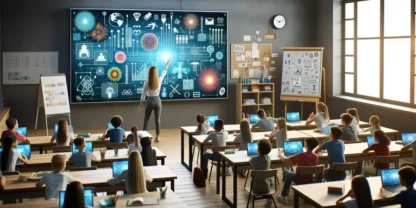The end of the school year is an exciting time for teachers and students. While the kids in your class are looking forward to summer camps and warm days playing with friends, you are looking forward to a little downtime and opportunities to plan for next year. However, don’t let your kids run out of the classroom and into the next grade just yet. Instead, choose a few activities for the end of the school year to help your students connect with their time in your class.
With these activities, students can reflect on the topics they learned and the friendships they made. Here are seven ideas you can add to lesson plans for a fun and educational time.

1. Let Students Provide End of Year Advice
Kids develop so quickly that the students who walked into your classroom last fall are completely different today. Even a single year between students can make a difference in maturity and knowledge. During the last week of school, give students an opportunity to reflect on what they learned and what they wish they knew at the start of this year.
You can create a variety of lesson plans around this concept. For example:
- Ask students to write letters to their past selves telling them what they need to know.
- Challenge students to create brochures for your classroom, highlighting the keys to success.
- Develop tips for rising students – and consider sharing this advice with the grade below. Maybe the advice your current students give to future students will make classroom management easier next year.
These activities can be useful for notable grade changes. Rising middle school students often seek advice from older peers. Even rising fifth-graders want tips to make the most of their last year in elementary school. Plus this activity allows your current students to reflect on what they have learned and overcome this year.
2. Build Time Capsules
There are some memories that your students will cherish when they are older that they don’t care about today. Consider asking your students to create time capsules with assignments, information, and other mementos that will remind them of their time in your classroom. This is a good way to let your students take home their best work at the end of the year in a format they might preserve.
If you teach younger students, consider setting the time capsule open date to the year they will graduate high school. This way, families can preserve the boxes and open them when their teenagers are prepared to enter adulthood. Imagine the flood of memories that will come pouring out when they encounter the art, handwriting, and favorite toys of their childhood selves.
3. Create End of Year Poems or Songs
Another way to honor the end of the school year is by asking students to write poems or change the lyrics of their favorite songs to highlight some of the most notable events from the past few months. These poems can talk about what students learned (what rhymes with multiplication?) or they can highlight events like fun school assemblies or sports competitions.
You can decide how closely this activity aligns with your curriculum goals. This could be an opportunity to introduce students to key poetry concepts or it could be a fun writing exercise to get the creative juices flowing.
4. Develop a Video Yearbook
While yearbooks are standard in most schools, you can create an extra memento for students with a video yearbook. Each student will record a short message to the class and all of these messages will be compiled into one reel. You can show the full video on the last day of school so everyone can hear the well-wishes of their peers.
If you decide to do this, develop a structure so you can easily compile messages. Some of your chattier students might try to create a 10-minute-long TED Talk for their peers and you don’t want to edit that down.
- Limit the time each student has to record a message to under a minute.
- Develop one key questions for each student to answer. (What is their favorite memory? What is the coolest fact they learned?)
- Consider filming these videos during school. This makes the process less uncomfortable for less-privileged students who might not have smartphones to record on.
- Make sure every message is school-appropriate.
You can send the video yearbook to parents on the last day so students can watch the recording whenever they want – especially if they miss their friends over the summer.
5. Ask Students to List What they Learned from A to Z
With so many subjects, lessons, and classes, it’s easy to get overwhelmed by the sheer amount of information that students learn throughout the year. This lesson plan allows students to look back on everything they learned and to list out exactly 26 subjects or ideas that stuck with them.
Develop a worksheet with the letters A to Z and spaces to fill in information. Ask each student to list something they learned that starts with the corresponding letter. To make this a bigger project, you can have students draw a representation of what they learned or explain why this information is useful to them.
For example, one student might write about commas for the letter C. What does a comma do? When is it used? Another student might write about comets or condensation or Columbus or calculations for that letter. This is a great way for students to share their favorite lessons and topics throughout the year.
6. Write Thank-You Notes
Kids will write thank-you notes all of their lives. They will thank potential employers for interviewing them and will thank wedding guests for their generous gifts. You can teach this skill by asking students to write thank-you notes at the end of the year.
Ask each student to pick someone in the school to write a thank-you note to. One student could pick their music teacher while another student writes a letter to the janitor. Before the year ends, make sure these notes get delivered and spread joy and appreciation throughout your school.
7. Take a Field Trip to the Next Grade
Even if your students are staying in the same school, moving grades can be scary. Your students will have new teachers, different classrooms, and might even learn in a different wing of the school. You can use the last day to prepare students for the fall.
Walk your students down to where the next grade learns. Let them visit the different classrooms to see where they might have their homeroom periods next year. You can even introduce your students to different teachers who they might learn from. Even these small actions and interactions can make the changes that come with a new school year seem less intimidating.
Let Students Show What They Know with eSpark
The end of the school year is a time for reflection and celebration. Your kids mastered everything they needed to learn and can move forward confidently. While eSpark is a tool that can engage students and add to your lesson plans throughout the year, it can also be introduced as an end-of-year reward. Let your students see how far they have come, how their vocabulary has improved, and how their math skills have thrived. They might be surprised by what they know.
Try eSpark today and see how it can engage students in your classroom – especially when they are more focused on summer fun than end-of-year lessons.



